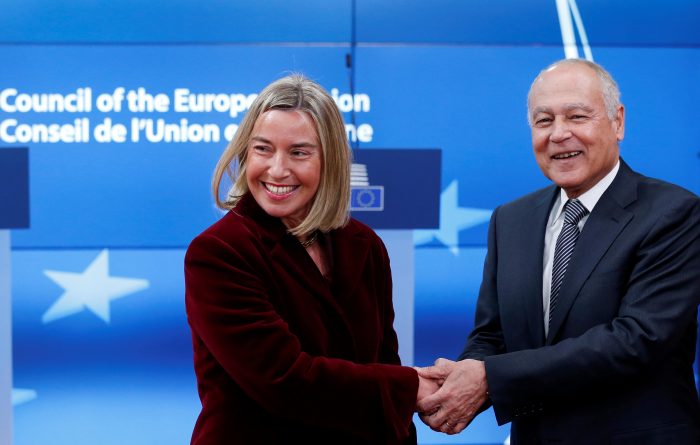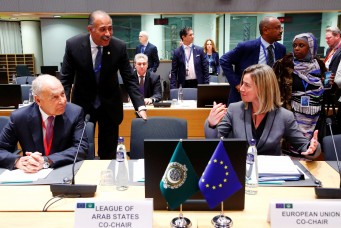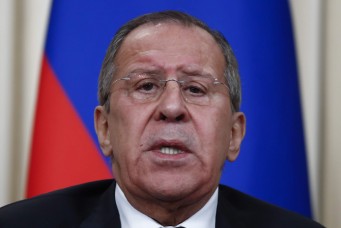What Future for the EU’s Southern Neighbourhood Policy?
The upcoming EU-Arab summit could help in crafting a new regional relationship.

European Union foreign policy chief Federica Mogherini welcomes Arab League Secretary-General Ahmed Aboul Gheit ahead of a meeting to discuss the Middle East peace process, in Brussels, Belgium, February 26, 2018. Francois Lenoir/Reuters
There was a time in the 1990s when it seemed that the bad old days of superpower rivalry were behind us, peace in the Middle East was imminent, and regional integration of the type pioneered by the European Union was on the march. A child of those times, the Barcelona Declaration of 1995, now looks like a high point for multilateralism in what the European Union (EU) terms the “Southern neighbourhood.”
The Euro-Mediterranean partnership (EMP) launched back then aimed among other things to establish a free trade area by 2010, as well as regional processes across the board, from security to cultural relations, with new financial commitments to back these processes up.
In addition, bilateral relations with the diverse countries of the South, which were “divided in their unity,” were also given a boost, as negotiations on new EU Association Agreements (AAs) got underway, as AAs were signed with all EMP countries except Syria by the early 2000’s.
Those agreements had a number of common aspects, including on regional cooperation but were essentially tailored to the differing circumstances of each country, so that while the AAs with less developed partners like Egypt and Palestine stressed economic and social development, the Association Agreements with Israel focussed on trade liberalisation. These AAs have largely stood the test of time and today are certainly the most robust legal basis and arguably, one of the most important political instruments underlying the EU’s relations with the Middle East and North Africa.
Yet, the regional environment has evidently changed in ways that no one could have foreseen back in the nineties. Contrary to Fukuyama’s infamous thesis of the time, history did not come to an end. Indeed the past twenty years or so has seen an avalanche of it, not least in the ENP countries, starting with the assassination of Yitzhak Rabin in the same month as Barcelona was announced, which largely put an end to Middle East peace prospects, through the invasion of Iraq, the Arab uprisings of 2011 and their aftermath, to the advent of the terror and migration crises which have rocked both sides of the Mediterranean in recent years.
Moreover, interventions of players other than the Americans have brought about a distinct turn for the worse when it comes to multilateralist approaches. Russia’s resurgence in Syria and, to a lesser but significant extent in other parts of the Middle East and North Africa, is the most obvious example. Turkey and Iran have also gone in for power projection based almost entirely on national interests.
At the same time, the United States, once a generally benign partner in encouraging regional integration, has scaled back its involvement, focussing mainly on fighting extremism and overtly taking sides in the Middle East, (notably Donald Trump’s December 2017 announcement on Jerusalem as Israel’s capital and subsequent withdrawal of support for the Palestinians).This, together with Trump’s pull-out from the Iran nuclear deal—perhaps the best contemporary example of how multilateral processes can make the world a safer place—has brought Europe into unprecedented discordance with its traditional ally.
Partially because of Trump’s policies, Saudi Arabia and some of the Gulf countries have also become more active, flexing their financial and political muscle, sometimes for good (as in the support for Egypt’s economic reforms under its IMF program) but sometimes not (as in the Saudis penchant for military solutions to conflicts which the EU would prefer to be ended through UN-led processes). And, the fall-out from worsening GCC/Iran tensions is yet another factor deepening fissures in the region, for example in the evolving Saudi relationship with Israel, based mainly on common cause against Tehran.
These developments have led to the region becoming more fractured and fragile than ever before, and left the high ambitions of Barcelona in 1995 looking like cathedrals in the desert.
Whereas it was once seen largely as an area of opportunity—some used to argue that it was itself a proto-EU in the making—the “Southern neighbourhood” is today often regarded as a place dominated by dangerous conflicts and threats, even if some of the countries in the region, notably Morocco, Tunisia, and Jordan, have continued to make generally peaceful progress. But one thing is certain: the mantra of the EU’s 2016 Global Strategy, that external security, especially in the MENA area, is essential to Europe’s internal security, was well received by European leaders and citizens and continues to resonate today.
Bilateral or Bust?
So perhaps it is no wonder that the revised European neighbourhood Policy, while continuing support for multisectoral regional programs and organisations like the Union for the Mediterranean (UfM), has prioritised security and stability as key drivers for relations with the South. And since there is a lack of credible regional interlocutors in these areas, the EU now focuses more on the bilateral dimension, though one should add that there has also been an important new effort to upgrade the exchanges with the Arab League, involving both political dialogue and action.
However, one is bound to wonder whether the EU is properly equipped to handle this new bilateralism in areas like security. An entity which is itself founded on (an albeit successful) post-Westphalian vision of peaceful cooperation is bound to be seriously challenged when having to deal with issues like counter-terrorism, especially when its partners are states that are preoccupied with national sovereignty, at best only partly democratic in nature, and are often governed by regimes with a high degree of involvement by the military. The EU’s complex relations in the region are constrained by the fact that the EU, as an institution, has only limited security mandates, capabilities, and experience.
Egypt is a case in point, and a brief look at the EU-Egypt relationship is instructive. The new “partnership priorities agreement” (PPA) under the revised ENP were agreed in July 2017, and as elsewhere in the region, include a strong commitment to the joint fight against terror and violent extremism, involving a comprehensive approach addressing root causes, and, to quote from the agreement, “with due respect for human rights and fundamental freedoms, in order to counter and prevent radicalisation and promote socio-economic development.”
Yet, despite major efforts by the European External Action Service and some member states, security cooperation with the EU institutions remains at a rather low level, with disagreements over equipment supply and the deployment of expert personnel to the EU delegation in Cairo. Discord on what constitutes due respect of rights standards and Europe’s refusal to treat the Muslim Brotherhood as a terrorist organisation have also caused a good deal of friction.
With the two sides yet to find a modus operandi, it is a moot point whether much progress can be made. The EU is also not always helped by member states that fail to support these efforts or prefer to focus on other priorities, such as the supply of conventional armaments to Cairo, which among other things sometimes undermines the spirit, if not the letter, of standing restrictions on arms supplies at EU level that date from 2013.
On the other hand, there have been somewhat better results in the exchanges on migration, the other new priority in the PP agreement. Political dialogue on this has been ramped up, notably through the recent visit to President Abdel Fattah El-Sisi by EU Council President Donald Tusk and Austrian Chancellor Kurz, and after long delays, the first Egyptian projects under the EU’s Valletta facility are getting underway. Cooperation between the Egyptian Navy and Operation Sophia on countering human trafficking and assisting its victims is improving, as Cairo seems to have understood that at least when it comes to the high seas, EU military coordination has real meaning. That said, there is little sign of progress on forging a mobility partnership of the kind that is being negotiated with other partners in the region.
All this points to a classic weakness in the bilateral approach: since security is not a core European competence, absent a visible and coherent all-EU presence, the dialogue is not in practice “bilateral” in the full meaning of the word. Knowing this, Cairo can play one EU entity against the other when faced with demands that it does not like.
While it accounts for a third of the region’s population, Egypt may not be typical of the MENA as a whole, yet it does provide an illustration of some of the limits to bilateralism in the current context.
On the other hand, bilateral trade talks on deep and comprehensive free trade agreements (DCFTA) are underway with Morocco, Tunisia, and Jordan and there is some hope that they will come to fruition. Even Egypt, which has traditionally been sceptical, has recently shown some interest in moving forward, at least on some aspects, although it is too soon to judge whether this will be sustained.
Is There a Future for Regionalism?
Notwithstanding these initiatives, the fact is that for all the efforts since 1995 to create that elusive free trade area, the MENA region is still one of the least economically integrated areas of the world. “South-South” exchange remains limited and this lack of interdependence continues to be a real drag on prospects for strengthening regional relations. Intra-regional processes such as Agadir have not made much headway and the UfM has struggled, especially beyond the Magreb region, to find a role for itself in stimulating investment in regional infrastructure.
ENP regional development programs continue and a few have had some success, notably in creating networks between officials, policymakers, businesspeople, and civil society in sectors such as energy, technology, and youth. But their effect is limited.
Given this, and the fact that, as noted, Saudi Arabia and the Gulf are playing an ever greater role in the affairs of the neighborhood, it may be time to seriously consider new political initiatives on the regional front that go beyond the somewhat artificial construct of the Southern neighborhood approach. One such initiative is the holding of a first Euro-Arab summit, set for February 2019.
The EU holds regular summit meetings with most key partner countries and regions around the world, but there is one major region that has been conspicuous by its absence from the summit agenda, i.e. the Arab World, which is an odd given the host of common challenges that preoccupy both the EU and this region. The former secretary general of the Arab League Nabil Al-Araby, who campaigned constantly for the idea of a summit, would consistently make this point to visiting European politicians, who were generally hard put to find a plausible reason why a joint meeting between the EU and the League of Arab Nations (LAS)has yet to occur.
However, in December 2016 at the last EU-LAS Foreign Ministers’ meeting in Cairo an agreement was struck on the summit and serious preparations are, albeit a little belatedly, now underway. It will be an ambitious undertaking, involving some fifty countries (twenty-eight plus institutions on the EU side and the twenty-two Arab League member states) represented at head of state and/or government level.
The summit provides a real opportunity but also involves risks: it certainly will not be easy to come up with meaningful common political messages on the most important issues, and there is a risk that it will degenerate into a talking shop.
Turning to what the substance of such a meeting could be, as noted, one of the many reasons why MENA and indeed the Gulf region are in such disarray is the woeful lack of progress on integration, despite historical affinities and it being home to the world’s oldest post-war regional institution, namely the Arab League.
With that in mind, and without wishing to exaggerate the EU’s influence on its Arab partners, the fact that the European Union would find it useful to upgrade its political relationship with the LAS as a group could help the latter regain some credibility with its own membership and citizens. That in turn might help it to take on a greater role in bringing peace and development to this atomized region.
Secondly, with a little imagination, it should be possible for the two sides to come up with some influential common messaging. At a time when the U.S. has for now, to coin a phrase, taken itself off the table as an honest broker in the wake of the Jerusalem announcement, and where there is a dearth of viable alternatives, it is worth recalling that both the EU and the LAS have long been committed to the two-state solution and the Arab Peace Initiative, although few European or Arab leaders today seem to give this the attention it deserves. Crafting a strong common position which directly engages all parties could help to inject energy into the moribund peace process. Without that, the drums of war for yet another round of violence in Palestine and Israel will only beat louder, among other things giving extremists in the MENA region and in Europe new succour.
Apart from the appalling suffering visited on the peoples of those countries, the fallout from conflicts in Syria, Libya, Iraq, and Yemen is fuelling instability, whether through the rise of Islamophobia and populism, or through unsustainable policies of repression in the name of security. A Euro-Arab summit in itself will not bring peace, not least because some of the parties to those wars will not be present, but again, it could give momentum to efforts, especially those led by the UN, to find solutions.
A summit might also help to sharpen joint action to fight the deprivation, terrorism, and irregular migration generated by these conflicts, which gnaw at the roots of societies on both sides. And depending on developments in the coming months, there may be room for discussion about how best to cooperate on post-war governance and reconstruction, wherever that is a feasible proposition.
The summit could also address the deep-rooted economic challenges that the region faces. It may well be that after a few false starts, the transition to a post-hydrocarbon world has now begun in earnest and this obviously has fundamental, possibly existential consequences for a number of LAS countries, oil exporters and consumers alike. Saudi Arabia’s “Vision 2030” program is one sign that Arab governments now take this vision seriously.
Europe is—and most likely will continue to be—the prime source of foreign investment, development aid, and trade for the region and has a vital part to play in its economic security, something that is evidently in the EU’s own interest as well. One way to do more in the economic field is through forging closer cooperation between the EU, UfM, European Development Banks, and the Arab Funds on boosting investment on infrastructure and job creation in MENA. Up to now, there has been much talk about this, but not a great deal of action.
Moreover, the two regions’ private sector organizations and companies could organise a parallel exchange on investment. And given their crucial role in development and governance, civil society groups could also come together, even if there will undoubtedly be diverging opinions about how that should be managed.
The EU already has a wide-ranging program of economic, development and security-related regional cooperation with the LAS Secretariat, mainly under the ENP, and there is an ambitious work program in areas such as energy, the environment, and crisis management. While there have been some achievements, for example in raising the League’s capacity to better monitor and help abate humanitarian crises, the summit could give new direction to calibrating these efforts to tackle new challenges in the region, and provide some operational deliverables.
Last but not least, summits like this always give an opportunity for leaders to solve or at least progress bilateral issues, whether they be within or between the respective regions.
Summits do not in and of themselves solve problems, and as said, given the enormous challenges, this summit entails considerable risks. The key will be in the quality of the preparations for it, and much work remains to be done by both sides in a relatively short period of time. But if suitable common cause can be forged, the event could give real impulsion to the Euro-Arab relationship, contribute to peace and development, and help to revive much-needed regional integration processes, to the benefit of all.
To go back to where this piece started, in finding ways forward. Leaders could do worse than revisit the spirit of collaboration and joint ownership that marked the original Barcelona process, even if the regional grouping and preoccupations included in that initiative have been overtaken by events on both sides of the Med since the heady days of 1995.
James Moran is a Senior Fellow at the Centre for European Policy Studies in Brussels. He was formerly the EU Ambassador to Egypt from 2012 to 2016, EU envoy to Libya in 2011 and Ambassador to Jordan and Yemen in 1999-2002.
Read More



